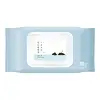What's inside
What's inside
 Key Ingredients
Key Ingredients

 Benefits
Benefits

 Concerns
Concerns

No concerns
 Ingredients Side-by-side
Ingredients Side-by-side

Water
Skin ConditioningDipropylene Glycol
HumectantPEG-7 Caprylic/Capric Glycerides
EmulsifyingPEG-15 Glyceryl Isostearate
EmulsifyingGlycerin
HumectantCentella Asiatica Extract
CleansingSodium Hyaluronate
HumectantMelaleuca Alternifolia Leaf Extract
PerfumingCucumis Sativus Fruit Extract
EmollientPyrus Malus Fruit Extract
Skin ConditioningPunica Granatum Fruit Extract
AntioxidantSodium Pantothenate
Butylene Glycol
HumectantRosa Damascena Flower Oil
Masking1,2-Hexanediol
Skin ConditioningSodium Citrate
BufferingHydroxyacetophenone
AntioxidantEthylhexylglycerin
Skin ConditioningDisodium EDTA
Water, Dipropylene Glycol, PEG-7 Caprylic/Capric Glycerides, PEG-15 Glyceryl Isostearate, Glycerin, Centella Asiatica Extract, Sodium Hyaluronate, Melaleuca Alternifolia Leaf Extract, Cucumis Sativus Fruit Extract, Pyrus Malus Fruit Extract, Punica Granatum Fruit Extract, Sodium Pantothenate, Butylene Glycol, Rosa Damascena Flower Oil, 1,2-Hexanediol, Sodium Citrate, Hydroxyacetophenone, Ethylhexylglycerin, Disodium EDTA
Water
Skin ConditioningMethylpropanediol
SolventDipropylene Glycol
HumectantPolyglyceryl-6 Caprylate
EmulsifyingSea Water
HumectantSodium Hyaluronate
HumectantSodium Acetylated Hyaluronate
HumectantHydrolyzed Hyaluronic Acid
HumectantAllantoin
Skin ConditioningDipotassium Glycyrrhizate
HumectantPanthenol
Skin ConditioningMaltodextrin
AbsorbentSodium Metabisulfite
AntioxidantProtease
ExfoliatingPolyglyceryl-4 Caprate
EmulsifyingSodium Citrate
BufferingHydroxyacetophenone
AntioxidantDecylene Glycol
Skin ConditioningLaurylpyridinium Chloride
AntimicrobialLevulinic Acid
PerfumingSodium Levulinate
Skin ConditioningDisodium EDTA
1,2-Hexanediol
Skin ConditioningCitric Acid
BufferingWater, Methylpropanediol, Dipropylene Glycol, Polyglyceryl-6 Caprylate, Sea Water, Sodium Hyaluronate, Sodium Acetylated Hyaluronate, Hydrolyzed Hyaluronic Acid, Allantoin, Dipotassium Glycyrrhizate, Panthenol, Maltodextrin, Sodium Metabisulfite, Protease, Polyglyceryl-4 Caprate, Sodium Citrate, Hydroxyacetophenone, Decylene Glycol, Laurylpyridinium Chloride, Levulinic Acid, Sodium Levulinate, Disodium EDTA, 1,2-Hexanediol, Citric Acid
Ingredients Explained
These ingredients are found in both products.
Ingredients higher up in an ingredient list are typically present in a larger amount.
1,2-Hexanediol is a synthetic liquid and another multi-functional powerhouse.
It is a:
- Humectant, drawing moisture into the skin
- Emollient, helping to soften skin
- Solvent, dispersing and stabilizing formulas
- Preservative booster, enhancing the antimicrobial activity of other preservatives
Dipropylene Glycol is a synthetically created humectant, stabilizer, and solvent.
This ingredient helps:
Dipropylene glycol is technically an alcohol, but it belongs to the glycol family (often considered part of the ‘good’ alcohols). This means it is hydrating and gentle on skin unlike drying solvent alcohols like denatured alcohol.
As a masking agent, Dipropylene Glycol can be used to cover the smell of other ingredients. However, it does not have a scent.
Studies show Dipropylene Glycol is considered safe to use in skincare.
Learn more about Dipropylene GlycolDisodium EDTA plays a role in making products more stable by aiding other preservatives.
It is a chelating agent, meaning it neutralizes metal ions that may be found in a product.
Disodium EDTA is a salt of edetic acid and is found to be safe in cosmetic ingredients.
Learn more about Disodium EDTAHydroxyacetophenone is antioxidant with skin conditioning and soothing properties. It also boosts the efficiency of preservatives.
This ingredient is not irritating or sensitizing.
Sodium Citrate is the sodium salts of citric acid. In skincare, it is used to alter pH levels and acts as a preservative.
Its main functions are to maintain the pH of a product and neutralize metal ions.
The acidity of our skin is maintained by our glands and skin biome; normal pH level of skin is slightly acidic (~4.75-5.5).
Being slightly acidic allows our skin to create an "acid mantle". This acid mantle is a thin barrier that protects our skin from bacteria and contaminants.
Learn more about Sodium CitrateSodium Hyaluronate is hyaluronic acid's salt form. It is commonly derived from the sodium salt of hyaluronic acid.
Like hyaluronic acid, it is great at holding water and acts as a humectant. This makes it a great skin hydrating ingredient.
Sodium Hyaluronate is naturally occurring in our bodies and is mostly found in eye fluid and joints.
These are some other common types of Hyaluronic Acid:
Learn more about Sodium HyaluronateWater. It's the most common cosmetic ingredient of all. You'll usually see it at the top of ingredient lists, meaning that it makes up the largest part of the product.
So why is it so popular? Water most often acts as a solvent - this means that it helps dissolve other ingredients into the formulation.
You'll also recognize water as that liquid we all need to stay alive. If you see this, drink a glass of water. Stay hydrated!
Learn more about Water